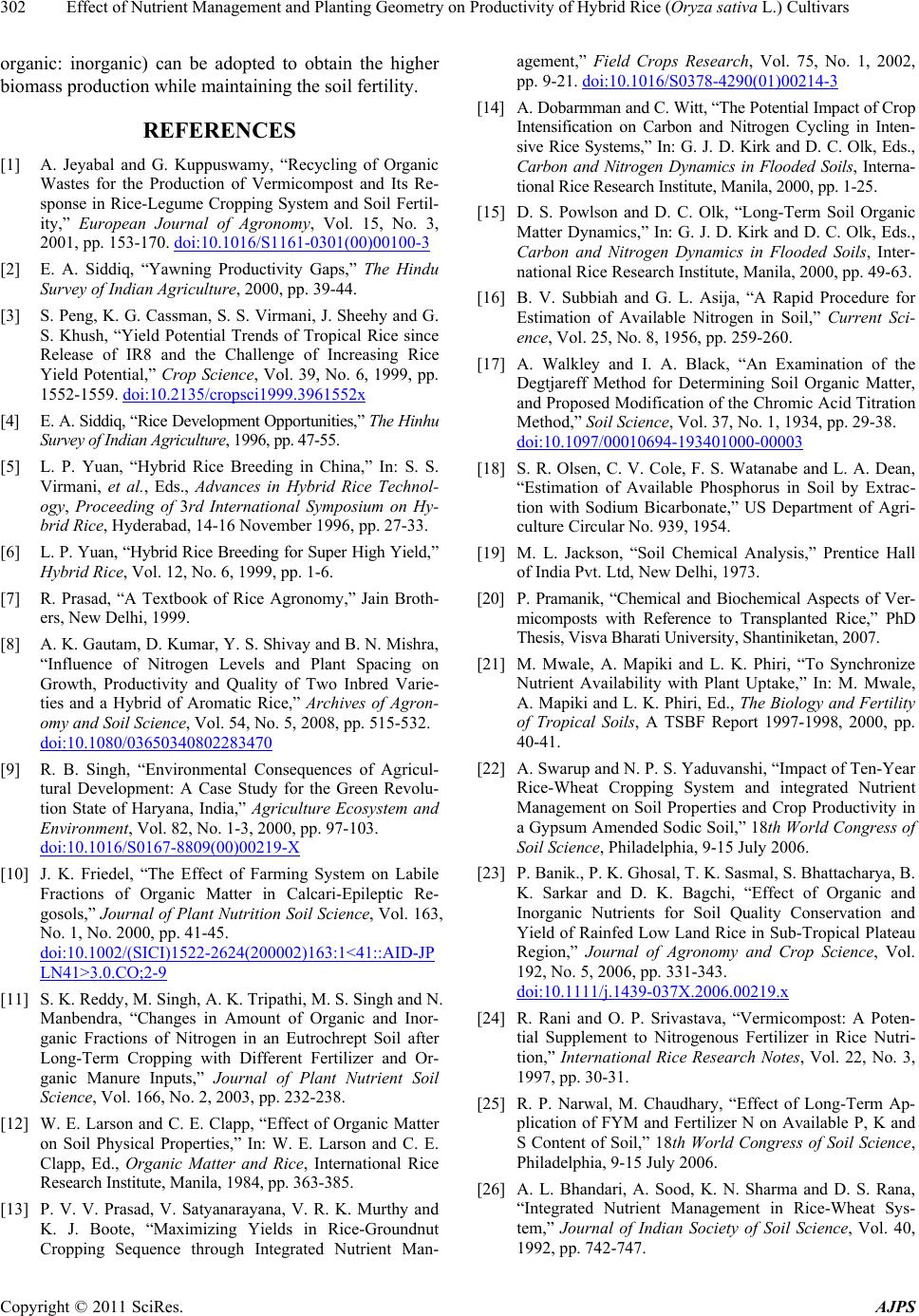
Effect of Nutrient Management and Planting Geometry on Productivity of Hybrid Rice (Oryza sativa L.) Cultivars
302
organic: inorganic) can be adopted to obtain the higher
biomass production while maintaining the soil fertility.
REFERENCES
[1] A. Jeyabal and G. Kuppuswamy, “Recycling of Organic
Wastes for the Production of Vermicompost and Its Re-
sponse in Rice-Legume Cropping System and Soil Fertil-
ity,” European Journal of Agronomy, Vol. 15, No. 3,
2001, pp. 153-170. doi:10.1016/S1161-0301(00)00100-3
[2] E. A. Siddiq, “Yawning Productivity Gaps,” The Hindu
Survey of Indian Agriculture, 2000, pp. 39-44.
[3] S. Peng, K. G. Cassman, S. S. Virmani, J. Sheehy and G.
S. Khush, “Yield Potential Trends of Tropical Rice since
Release of IR8 and the Challenge of Increasing Rice
Yield Potential,” Crop Science, Vol. 39, No. 6, 1999, pp.
1552-1559. doi:10.2135/cropsci1999.3961552x
[4] E. A. Siddiq, “Rice Development Opportunities,” The Hinhu
Survey of Indian Agriculture, 1996, pp. 47-5 5.
[5] L. P. Yuan, “Hybrid Rice Breeding in China,” In: S. S.
Virmani, et al., Eds., Advances in Hybrid Rice Technol-
ogy, Proceeding of 3rd International Symposium on Hy-
brid Rice, Hyderabad, 14-16 November 1996, pp. 27-33.
[6] L. P. Yuan, “Hybrid Rice Breeding for Super High Yield, ”
Hybrid Rice, Vol. 12, No. 6, 1999, pp. 1-6.
[7] R. Prasad, “A Textbook of Rice Agronomy,” Jain Broth-
ers, New Delhi, 1999.
[8] A. K. Gautam, D. Kumar, Y. S. Shivay and B. N. Mishra,
“Influence of Nitrogen Levels and Plant Spacing on
Growth, Productivity and Quality of Two Inbred Varie-
ties and a Hybrid of Aromatic Rice,” Archives of Agron-
omy and Soil Science, Vol. 54, No. 5, 2008, pp. 515-532.
doi:10.1080/03650340802283470
[9] R. B. Singh, “Environmental Consequences of Agricul-
tural Development: A Case Study for the Green Revolu-
tion State of Haryana, India,” Agriculture Ecosystem and
Environment, Vol. 82, No. 1-3, 2000, pp. 97-103.
doi:10.1016/S0167-8809(00)00219-X
[10] J. K. Friedel, “The Effect of Farming System on Labile
Fractions of Organic Matter in Calcari-Epileptic Re-
gosols,” Journal of Plant Nutrition Soil Science, Vol. 163,
No. 1, No. 2000, pp. 41-45.
doi:10.1002/(SICI)1522-2624(200002)163:1<41::AID-JP
LN41>3.0.CO;2-9
[11] S. K. Reddy, M. Singh, A. K. Tripathi, M. S. Singh and N.
Manbendra, “Changes in Amount of Organic and Inor-
ganic Fractions of Nitrogen in an Eutrochrept Soil after
Long-Term Cropping with Different Fertilizer and Or-
ganic Manure Inputs,” Journal of Plant Nutrient Soil
Science, Vol. 166, No. 2, 2003, pp. 232-238.
[12] W. E. Larson and C. E. Clapp, “Effect of Organic Matter
on Soil Physical Properties,” In: W. E. Larson and C. E.
Clapp, Ed., Organic Matter and Rice, International Rice
Research Institute, Manila, 1984, pp. 363-385.
[13] P. V. V. Prasad, V. Satyanarayana, V. R. K. Murthy and
K. J. Boote, “Maximizing Yields in Rice-Groundnut
Cropping Sequence through Integrated Nutrient Man-
agement,” Field Crops Research, Vol. 75, No. 1, 2002,
pp. 9-21. doi:10.1016/S0378-4290(01)00214-3
[14] A. Dobarmman and C. Witt, “The Potential Impact of Crop
Intensification on Carbon and Nitrogen Cycling in Inten-
sive Rice Systems,” In: G. J. D. Kirk and D. C. Olk, Eds.,
Carbon and Nitrogen Dynamics in Flooded Soils, Interna-
tional Rice Research Institute, Manila, 2000, pp. 1-25.
[15] D. S. Powlson and D. C. Olk, “Long-Term Soil Organic
Matter Dy namics,” In: G. J. D. Kirk and D. C. Olk, Eds.,
Carbon and Nitrogen Dynamics in Flooded Soils, Inter-
national Rice Research Institute, Manila, 2000, pp. 49-63.
[16] B. V. Subbiah and G. L. Asija, “A Rapid Procedure for
Estimation of Available Nitrogen in Soil,” Current Sci-
ence, Vol. 25, No. 8, 1956, pp. 259-260.
[17] A. Walkley and I. A. Black, “An Examination of the
Degtjareff Method for Determining Soil Organic Matter,
and Proposed Modification of the Chromic Acid Titration
Method,” Soil Science, Vol. 37, No. 1, 1934, pp. 29-38.
doi:10.1097/00010694-193401000-00003
[18] S. R. Olsen, C. V. Cole, F. S. Watanabe and L. A. Dean,
“Estimation of Available Phosphorus in Soil by Extrac-
tion with Sodium Bicarbonate,” US Department of Agri-
culture Circular No. 939, 1954.
[19] M. L. Jackson, “Soil Chemical Analysis,” Prentice Hall
of India Pvt. Ltd, New Delhi, 1973.
[20] P. Pramanik, “Chemical and Biochemical Aspects of Ver-
micomposts with Reference to Transplanted Rice,” PhD
Thesis, Visva Bharati University, Shantiniketan, 2007.
[21] M. Mwale, A. Mapiki and L. K. Phiri, “To Synchronize
Nutrient Availability with Plant Uptake,” In: M. Mwale,
A. Mapiki and L. K. Phiri, Ed., The Biology and Fertility
of Tropical Soils, A TSBF Report 1997-1998, 2000, pp.
40-41.
[22] A. Swarup and N. P. S. Yaduvanshi, “Impact of Ten-Year
Rice-Wheat Cropping System and integrated Nutrient
Management on Soil Properties and Crop Productivity in
a Gypsum Amended Sodic Soil,” 18th World Congress of
Soil Science, Philadelphia, 9-15 July 2006.
[23] P. Banik., P. K. Ghosal, T. K. Sasma l, S. Bhattachary a, B.
K. Sarkar and D. K. Bagchi, “Effect of Organic and
Inorganic Nutrients for Soil Quality Conservation and
Yield of Rainfed Low Land Rice in Sub-Tropical Plateau
Region,” Journal of Agronomy and Crop Science, Vol.
192, No. 5, 2006, pp. 331-343.
doi:10.1111/j.1439-037X.2006.00219.x
[24] R. Rani and O. P. Srivastava, “Vermicompost: A Poten-
tial Supplement to Nitrogenous Fertilizer in Rice Nutri-
tion,” International Rice Research Notes, Vol. 22, No. 3,
1997, pp. 30-31.
[25] R. P. Narwal, M. Chaudhary, “Effect of Long-Term Ap-
plication of FYM and Fertilizer N on Available P, K and
S Content of Soil,” 18th World Congress of Soil Science,
Philadelphia, 9-15 July 2006.
[26] A. L. Bhandari, A. Sood, K. N. Sharma and D. S. Rana,
“Integrated Nutrient Management in Rice-Wheat Sys-
tem,” Journal of Indian Society of Soil Science, Vol. 40,
1992, pp. 742-747.
Copyright © 2011 SciRes. AJPS